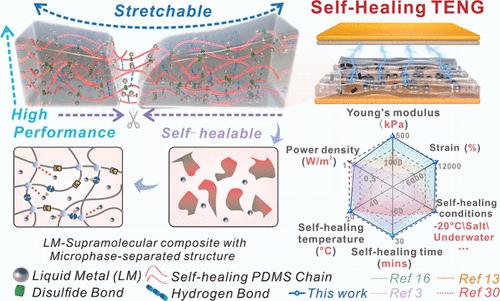液态金属促进的超分子相互作用实现了室温下高性能的超快自愈合三电材料
IF 9.1
1区 材料科学
Q1 CHEMISTRY, MULTIDISCIPLINARY
引用次数: 0
摘要
软质自修复材料由于其良好的顺应性、可扩展性和自修复性,是可穿戴设备供电传感器的优秀候选者。然而,将超快和自主修复性能与优异的机械性能结合起来应用于自供电可穿戴设备仍然存在挑战。利用液态金属的高迁移率和导电性,本文通过超分子界面组装策略将其融入聚二甲基硅氧烷中,制备出具有超高拉伸性(12000%)和显著自愈性(在~ 25°C下30分钟)的摩擦电材料。动态键使材料在极端环境(- 20℃、近红外和水下)、机械耐久性和摩擦电性能(100 V和0.81 W/m2)下具有优异和普遍的自愈能力。通过将材料集成到可穿戴的自供电设备中,可以实现对人体关节运动的实时反馈。这项工作提供了一种有价值的策略来平衡形状适应和自我修复之间的权衡,为增强在传感应用中的适用性铺平了道路。本文章由计算机程序翻译,如有差异,请以英文原文为准。

Liquid Metal-Promoted Supramolecular Interactions Enable Ultrafast Self-Healing Triboelectric Materials with High Performance at Room Temperature
Soft self-healing materials are excellent candidates for wearable devices to power sensors due to their excellent compliance, extensibility, and self-restorability. However, combining ultrafast and autonomous restorative properties with excellent mechanical capabilities for application in self-powered wearable device still poses challenges. Utilizing the high mobility and conductivity of liquid metal, this paper incorporates it into polydimethylsiloxane by a supramolecular interfacial assembly strategy to prepare a triboelectric material with ultrahigh stretchability (12000%) and remarkable self-healing (30 min at ∼25 °C). The dynamic bonds endow the material with excellent and universal self-healing ability under extreme environments (−20 °C, near infrared, and underwater), mechanical durability, and triboelectric properties (100 V and 0.81 W/m2). By integrating the material into wearable self-powered devices, real-time feedback on human joint movement is enabled. This work offers a valuable strategy to balance the trade-off between shape adaptation and self-healing, paving the way for enhanced applicability in sensing applications.
求助全文
通过发布文献求助,成功后即可免费获取论文全文。
去求助
来源期刊

Nano Letters
工程技术-材料科学:综合
CiteScore
16.80
自引率
2.80%
发文量
1182
审稿时长
1.4 months
期刊介绍:
Nano Letters serves as a dynamic platform for promptly disseminating original results in fundamental, applied, and emerging research across all facets of nanoscience and nanotechnology. A pivotal criterion for inclusion within Nano Letters is the convergence of at least two different areas or disciplines, ensuring a rich interdisciplinary scope. The journal is dedicated to fostering exploration in diverse areas, including:
- Experimental and theoretical findings on physical, chemical, and biological phenomena at the nanoscale
- Synthesis, characterization, and processing of organic, inorganic, polymer, and hybrid nanomaterials through physical, chemical, and biological methodologies
- Modeling and simulation of synthetic, assembly, and interaction processes
- Realization of integrated nanostructures and nano-engineered devices exhibiting advanced performance
- Applications of nanoscale materials in living and environmental systems
Nano Letters is committed to advancing and showcasing groundbreaking research that intersects various domains, fostering innovation and collaboration in the ever-evolving field of nanoscience and nanotechnology.
 求助内容:
求助内容: 应助结果提醒方式:
应助结果提醒方式:


